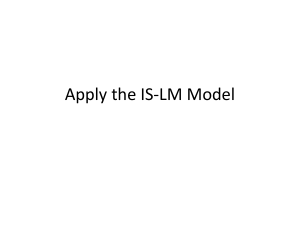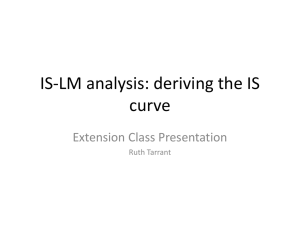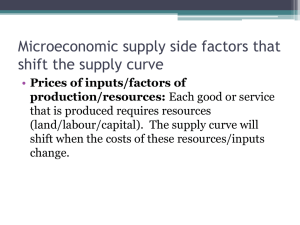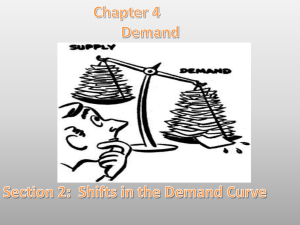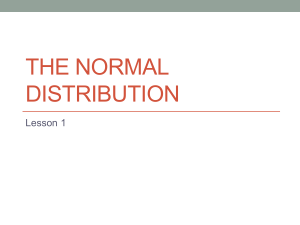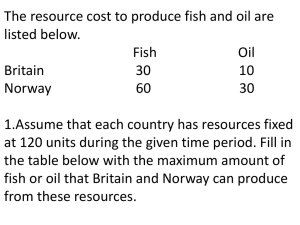Document
advertisement
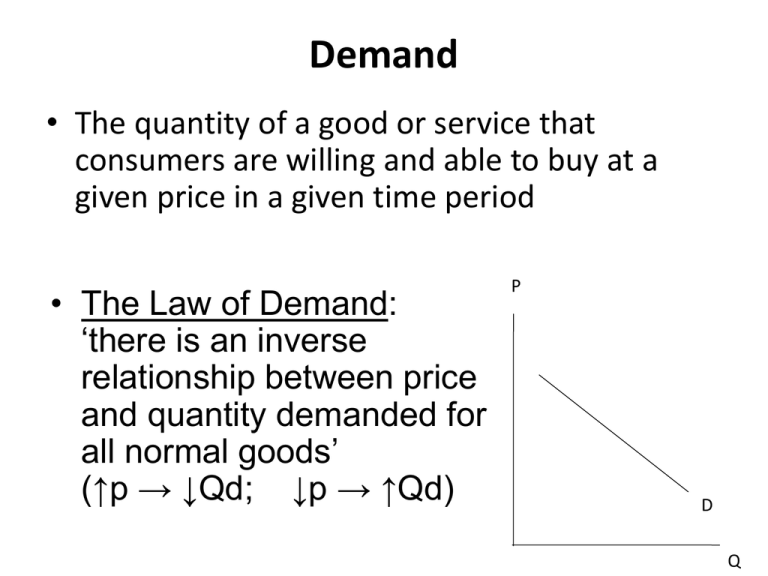
Demand • The quantity of a good or service that consumers are willing and able to buy at a given price in a given time period • The Law of Demand: ‘there is an inverse relationship between price and quantity demanded for all normal goods’ (↑p → ↓Qd; ↓p → ↑Qd) P D Q Supply • The quantity of a good or service that producers are willing and able to provide to the market at a given price in a given time period P •There is usually a positive relationship between price and quantity supplied (↑p → ↑ Qs; ↓p → ↓ Qs) S Q The Demand Curve P • A movement along the demand curve caused by a change in price Contraction Extension D Q The Supply Curve P S Extension Contraction Q • A movement along the supply curve caused by a change in price Equilibrium Market Price • A state of equality between demand and supply in a market – at a state of rest – all parties are happy P P1 S At P1, Qs > Qd price will fall as suppliers try to dispose of the surplus stock At P2, Qd > Qs price will rise as buyers are willing to pay a higher price to secure some stock. Pe P2 D Qe Q Movement comes to rest where D=S – called market equilibrium Charting Demand & Supply Supply Demand Price Quantity Price Quantity £3 4 £3 16 £6 8 £4.50 14 £7.50 10 £7.50 10 £12 16 £12 4 1. Plot the above data on a graph 2. At what price do these two lines intersect 3. How much will be demanded at a price of £13.50 4. What is the consumer expenditure at the market equilibrium. 5. What is the firm’s revenue at the market equilibrium. Shifts in the Demand Curve P P D1 D Q Q1 • Changes impacting a market, other than price, will cause the demand curve to shift outward or inward Q • This outward / rightward shift shows an increase in Qd at any price Shifts in the Demand Curve P P D D1 Q1 Q Q • This inward/ leftward shift shows a decrease in Qd at any price What shifts the demand curve? • Changing price of substitutes • Changing price of complements • Changing incomes • Changes in tastes & preferences • Changes in interest rates • Advertising Decide whether the following events would cause a movement along a demand curve (extension or contraction) or a shift in the demand curve (increase or decrease) for Ford Cars. • A fall in the price of petrol • A fall in the price of Saab cars • A fall in the price of Ford cars • A rise in real disposable incomes • An advertising campaign for Ford cars • An increase in the punctuality and comfort of rail travel Shifts in the Supply Curve Changes impacting producers in the market, other than price, will shift the supply curve. P P S1 S S P P Q1 Q Q Inward / leftward shifts in supply indicate a decrease in quantity supplied at every price. S1 Q Q1 Q Outward / rightward shifts in supply indicate an increase in quantity supplied at every price. What shifts the supply curve? • Changing costs of production • Changing gov’t taxes & subsidies • Changes in climate / environment • Changing prices of substitute use for resources • Number of producers in the market Decide whether the following events would cause a movement along a supply curve (extension or contraction) or a shift in the supply curve (increase or decrease) for Ford Cars. • The use of advanced technology in Ford car plants • A fall in the cost of car components • A strike by Ford car workers • A rise in the productivity of ford car workers • A rise in the indirect tax imposed on cars • A rise in the price of Ford cars Shifts in Demand or Supply P A SHIFT in one curve will cause a MOVEMENT ALONG the other curve. S P1 A shift in one curve will NEVER cause a shift in the other curve. P D1 D Q Q1 Two curve may shift simultaneously, but of their own accord. Q This INCREASE in demand has caused an EXTENSION of supply. Market price has increased; quantity has increased. Shifts in Demand or Supply P A SHIFT in one curve will cause a MOVEMENT ALONG the other curve. S1 S P1 P D Q1 Q Q A shift in one curve will NEVER cause a shift in the other curve. Two curves may shift simultaneously, but of their own accord. This DECREASE in supply has caused a CONTRACTION in demand. Market price has increased, quantity has decreased.

